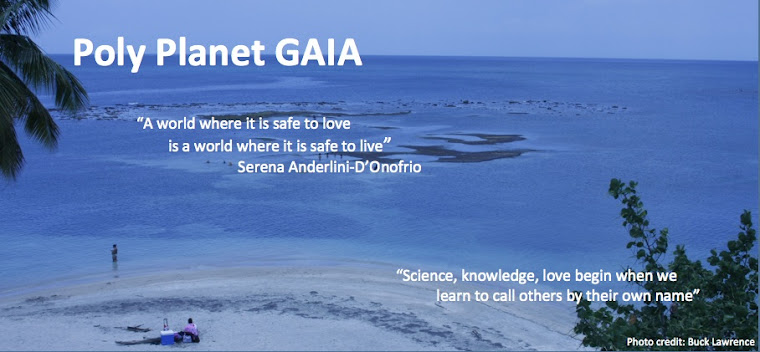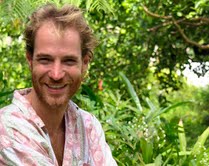"Bisexuality, Gaia, Eros: Portals to the Arts of Loving"
BiReCon: Selected Proceedings from the 2010 Int'l Bisexual Research Conference
Serena Anderlini-D'Onofrio, PhD, Keynote Speaker
Pert 1 - Preamble: Manifesting Bisexuality, Cont'd
The idea of a portal is useful to allude to the socially transformative potential of a certain subcultural group or community. In my view, bisexuality is strong with this potential when it comes in conjunction with other healthy, fun, cheerful styles of erotic expression that enhance imaginativeness and creativity. In many ways the conference confirmed this for me. The Renaissance festive tradition was mentioned in relation to bisexual readings of Shakespeare.[1] Styles of erotic expression one could observe at BiCon included cross-dressing, gothic, naturism, gender-queer, polyamory, mild BDSM, and others. Research presented alluded to the need to define styles of love beyond merely functional sexual activity, especially among young people.[2] In these and many other similar contexts bisexuality is liberating because it makes erotic expression more artistic.
When I claim that love is an art, I don’t mean to deny its other aspects.[3] Of course love is a need and an instinct. In that respect, like sex, it is also an appetite and a drive. The problem is with a culture that considers it primarily as such. What I propose is infusing new value in love’s artistic quality. As a bona-fide Italian, it behooves me to compare appetites. Another well-known human instinct is hunger. Food is what notoriously satisfies it. In relation to this appetite, I’d like to call attention to the fact that most people appreciate the art of satisfying one’s hunger in ways that are healthy, sophisticated, diverse, creative, artistic, and respectful of one’s inclinations. We ask for menus when we eat out. When cooking is good, we consider it an art. We call it cuisine! More to the point, we tend to respect various styles of eating, including gourmet, country, nouvelle cuisine, fusion, ethnic, healthy, macrobiotic, vegetarian, vegan, locavore (for locally grown foods), and many others. We value sampling various styles and combining them to meet the pleasure and health needs of those involved. As an advocate of bisexuality, let me offer here the following food for thought. If we only did the same with the arts of loving, the result would be a society where Eros, the force of love, is considered amicable. It would be a society where erotophilia is abundant, erotophobia scarce.[4] It would be, in short, a more loving, fun, and healthier society.
By comparison, one can easily get a measure of the damage incurred when the artistic aspect of love is neglected. Let’s pretend for a moment to apply to hunger the same monosexual, monogamous rules currently in use for sexuality. What if “experts” about that particular appetite prescribed the same food, cooked in the same style, every time one eats, “until death does one part” from life? How healthy, how loving, would that prescription be? And, would anybody even mind “parting”? Yet, when exclusivity is expected of sexual partners in both gender and number, that’s exactly what’s being asked! Take “fast food” for example. The “fast food” industry can be described as a response to hunger notoriously devoid of art. Fast food tends to encourage what may be termed “monovore” behavior because it is purely functional. Its dangers to the health and happiness of anyone have been recently documented in Super Size Me, a testimonial film about how one can gain 25 pounds in a month from an exclusive diet of Big Macs, plus various conditions leading to obesity, depression, and heart attacks. Let me propose for a moment that exclusivity in the practice of love could be just as damaging. If we can entertain that hypothesis, there is a big role to play for bisexuality. As a portal to a world beyond the homo/hetero divide, bisexuality can produce a culture that breaks away from gender binaries and welcomes erotic love again as a positive energy in human life.
The challenge is proving this in the current erotophobic cultural climate. A quick survey of the kind of research on bisexuality that has taken hold in academe in the AIDS era shows that male bisexuality appears mainly in relation to some impending danger, and often in the context of staving off criminalizing attitudes in the medical and other service professions.[5] Despite good intentions, the results are dubious. They seem to perpetuate prevailing myths. One title sounds especially lurid “Secret Encounters: Black Men, Bisexuality, and AIDS in Alabama” (Lichtenstein 1993). The Journal of Bisexuality has countervailed this, but have its voices been heard outside of bi circles?[6] Academe tends to provide a secular counterpoint to illiberal impulses from less culturally aware sectors of society, in a mainstream that can be easily manipulated through the media. A bevy of more current sources on sex-positive cultures is now available from respected scholars who, by their own admission, appreciate these cultures. They concur in indicating that early third-millennium societies are deeply divided about what sex is, what should be known about it, who should have it, where, when, and with whom.[7] The rift seems to be between circles where secular values prevail, and social groups organized around institutionalized styles of religion where fundamentalist fears have had their way.
Secular people today are much more familiar with styles of erotic expression beyond heteronormativity than when I was a kid, in the early 1960s. In many secular communities, erotophilia has expanded to embrace gay, lesbian, bi, trans, poly, pan, omni, gothic, BDSM, metro, eco, and many other labels people use to describe their styles of sexual expression. Free form spirituality, tantra, naturism, paganism, and swinging are also fairly erotophilic. However, erotophobia has also become extreme (Klein 2006). While in secular circles the AIDS crisis has promoted more awareness of sexual diversity, the same crisis has been manipulated by conservative political forces to wage what civil rights activist Marty Klein calls a full-fledged “war on sex” (Klein 2006). Can this war be won? Not as long as “Eros,” the energy of love, is what makes our hostess planet Gaia alive. Yet the rift is serious and bisexuality seems to fall through the cracks. When bisexuality becomes the location of aberrant desire in both mainstream public discourse and LGBT institutions, the artistic quality of love becomes invisible and the homo/hetero divide reigns supreme. If proactive research can undo this positioning, we can get a sense of how practicing love beyond gender can promote health in human communities. With renewed attention to the artistic quality of love, a holistic notion of sexual health can be articulated too.
[1] McLelland, in this volume.
[2] Ripley, and Anderson, in this volume.
[3] The idea that love is an art is not new. My main sources are Ovid (1957), from antiquity, and Fromm (1956), from the Frankfurt School. It’s a subtext in many other works too. The good thing about this idea is that it implies that love can be taught and one’s talents make one a good student.
[4] My main source on erotophobia is Ince, 2003. Erotophilia was discussed at the conference in relation to in-progress AIB research. The word comes from Eros, the name of the Greek god of love.
[5] Examples include Lever and Kanouse 1992, Lichtenstein 2000, Stokes and McKirnan 1993.
[6] My main sources are Worth (2003) and Miller (2002).
[7] My sources on this rift include Druckerman 2007, Ley 2009, Barash and Lipton 2001, Ince 2003, and Levine 2003.
Read the article as it continues to appear in Poly Planet GAIA. Section will be posted every three or four days. Become a follower of the blog and be notified every time a new posting appears.
Acknowledgment: This piece is pre-published here with permission of Routledge, New York, a division of Taylor and Francis.
BiReCon | 28 BiCon | 10 ICB
BiReCon Proceedings: A forthcoming issue of The Journal of Bisexuality
BiReCon | 28 BiCon | 10 ICB
Bisexuality Research Conference, 28th Bisexuality Conference, 10th International Conference on Bisexuality, London, UK, August 26-30, 2010
BiReCon Proceedings: A forthcoming issue of The Journal of Bisexuality













